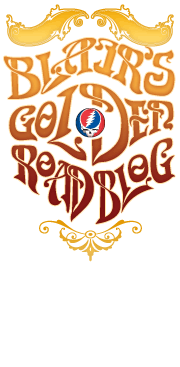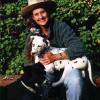What if on August 10, 1995, you opened up your morning newspaper and read the following: “Grateful Dead guitarist Jerry Garcia was rushed to a Marin County, California, hospital late last night and underwent successful quadruple bypass surgery. Garcia, 53, was said to be resting comfortably and joking with doctors and nurses. He is expected to make a full recovery and should be able to tour again with the Grateful Dead “somewhere between six months and a year from now,” a hospital spokesperson said, “depending on how seriously he takes this episode.”
It was the “IWAAJ” — “It was all about Jerry” — debate in this space a couple of weeks ago that got my mind wandering (again) to that great hypothetical: What if Jerry hadn’t died 16 years ago, and he had instead embraced the healthy lifestyle choices that would have perhaps allowed him to live this long? Would the Grateful Dead still be going strong? How would that turn of events have affected the course of our own lives? I know it’s difficult and probably fruitless to speculate, but let’s have a little fun with this.
So many Dead Heads jumped ship from the end of ’93 through ’95 because of what they saw as a steady and alarming decline in Garcia’s playing and overall demeanor. Would they have come back to the fold if he rose, Phoenix-like, in the spring of 1996—slimmer, healthier (off drugs, diabetes in check), cheerier and also fully rehabbed for the debilitating carpal tunnel malaise that so affected his manual dexterity? Absolutely! It would be like the spring of ’87 (post-diabetic coma) all over again.

I see Jerry singing ‘My Way,’
then going into ‘Idiot Wind’
with a 12-piece tuba section backing him."
During his convalescence, no doubt the New Jerry would have gotten together with Robert Hunter to write some fresh tunes, and though going on the road was verboten for a while, perhaps the band could have cut a new album using the best from those writing sessions along with the strongest of the still-unrecorded songs the band already had, including “So Many Roads,” “Corrina,” “Days Between,” “Lazy River Road,” “Eternity” and “Liberty.” A shortened version of “Liberty” becomes a surprise radio favorite, and everywhere the revivified band goes on their spring and summer tours in 1996, they are hailed as great survivors! They close the summer with a free concert at the Polo Fields in San Francisco’s Golden Gate Park, broadcast live over HBO. In a nod to the band’s return from their mid-’70s hiatus, the fall tour consists of 45 shows in small theaters, five each in nine cities, spread over October and November. An all-star New Year’s Eve concert—this one a low-priced pay-per-view event at the Fillmore in SF featuring a slew of the Dead’s musical friends, including Bob Dylan, Carlos Santana, Bonnie Raitt, Pete Townshend, Bruce Hornsby, Paul Barrere and Bill Payne from Little Feat and many others, is favorably compared to The Last Waltz. Martin Scorsese even directs the telecast.
OK, that fantasy is already out of control and we’re only a year into it! What really might have happened? Would the crowd problems that dogged the Dead’s last tours continue unabated? Probably. If ’87 is any indication, a renewed Grateful Dead would be an even greater draw than it was when they were at that creative low ebb in 1995. To keep the already large Grateful Dead organization humming along, the band would still have to play big arenas and “sheds” mostly; one hopes they would once and for all leave the stadiums behind. But would they have the sense and the willpower to do that? Maybe. Those of us who enjoyed traveling to shows always wished the band would go to Asia and Australia someday, just for kicks, but would the money-conscious brass allow that to happen?
Would the band ever get around to playing all those great nuggets that the post-Jerry bands have thrived on the past decade-plus, from “St. Stephen” and “The Eleven” to weirder stuff like “Born Cross-Eyed” and “What’s Become of the Baby”? Wow, that’s a tough one to answer. Jerry had a very unusual relationship with the Dead’s back catalog. He once told me definitively that he would never play “The Golden Road (To Unlimited Devotion)” again. That’s a shame. I dig it every time I hear it these days. I never understood his aversion to “St. Stephen” and “Dark Star”—especially the latter, as it was so mutable and timeless. It’s hard to imagine him singing “What’s Become of the Baby” or “Rosemary.” I think he viewed those as album curiosities from a past best forgotten. Might the band have played any of their classic albums in their entirety as so many bands do today—say a mini-tour performing Blues for Allah for that album’s 30th anniversary in 2005, or Workingman’s Dead and American Beauty for their 40th anniversary in 2010? I can’t see it, frankly, but you never know.
Any chance the band would have at least started mixing up their sets more, escaping the bland predictability that set in around, oh, 1990? As controllers of the repertoire, Garcia and Weir both seemed locked into their musical habits, and though occasionally in interviews they paid lip service to the notion of shaking things up, it never happened while Jerry was still with us. It was Phil, a few years after Garcia’s passing, who first mustered the courage to step outside the box and look at the placement of songs and structure of shows differently. Bob soon followed in RatDog, and though Furthur went back to the “first-set song/second-set song” formulation a bit on their most recent tour, they are still much more adventurous in the way they present songs and where in the show they occur than the latter-day Grateful Dead. Would Phil have stepped up at some point and suggested some radical reinvention of the Dead’s “show”? I doubt it, but I’d like to think so.
Because they were always more of a live attraction than a top recording band, the Dead might have been immune to some of the economic woes that befell so many groups in the digital file-sharing age. One would hope that they would not have increased ticket prices to the level of so many major attractions in the late ’90s and the 2000s. They always had a populist streak in them, so I think that’s a safe bet. To generate more income, though, they might have picked up the pace in archival releases somewhat. There was a time when Dick’s Picks and various multitrack vault releases were big sellers for the band, but that diminished over the years after Garcia’s death, aided by the flood of soundboard tapes that found their way onto Archive.org following Dick Latvala’s demise and were downloaded thousands of times for free (before the surviving band members put a stop to it).
I’d like to think we might still have been treated to epic box sets like the various Complete Recordings collections (Fillmore West ’69, Winterland ’73 and ’77, Europe ’72, Hampton ’89), but there probably wouldn’t have been anywhere near the volume of releases that have come out. On the Garcia side, there’s nothing to suggest that he was at all interested in putting out archival CDs of his various bands, and chances are the wonderful All Good Things box set, with its abundance of unreleased studio material, would not have seen the light of day. It’s hard to picture Jerry putting in the time and effort to look at his past studio efforts in a new light. He was always more interested in moving forward.
On a personal level, I would never have had the opportunity to write my biography of Jerry, Garcia: An American Life, while he was alive — my sources would have respected his privacy too much to talk to a journalist. I probably would not have been invited to work on archival releases or write liner notes. The Dead’s famed tape vault would have stayed in their hands, so there would be no release deal with Rhino and no Rhino/Grateful Dead website for me to write for. I’m sure I’d still be going dutifully to every local concert and no doubt buying CDs or downloads of every one they played. Can you imagine the crush of people trying to pick up CDs of a show they’d just attended? It would take hours to get out of there! And you can be sure that YouTube would be positively littered with videos of every song the Dead played at each show. Poor Jerry, having to look out on a sea of inattentive camera-phone videographers. “Remember when people listened?” he’d grumble one night to no one in particular backstage.
The mind races with thoughts about what might have become of the JGB if Jerry had lived and John Kahn had died when he did? Would he form some completely different kind of group? What of Jerry’s troubled personal life? Would Sirens of Titan ever get made? (The New York Times: “Garcia’s directorial effort is a delectable but uncompromisingly weird confection…” ) Would Jerry host Saturday Night Live? Record a “duets” album? Support a presidential candidate?
We’ll never know. But what do YOU think? What if Jerry had lived?
dead comment
To take it a step further...
I am STILL bumming
On Keyboard and Vocals, Mr. Keith Godchaux
Dead Yet- Garcia looks at 40
I'd be curious to see that, Weve...
Yes, wishful thinking , but
if wishes were horses
What if ,,,
cosmicbadger sums it up...
What if?
Good Blog this week
Technology - Reunions
Jer lived to play
If and ONLY if
absolutely~!
Bobby & the Midnites reunion?
Not a fan of the Midnites, no...
Too slick, songs weren't good. Excellent players, though! Went to a couple of gigs, I'm not sure I ever made it all the way through one... There was a pretty good live video of them I have buried in my VHS stacks somewhere....
I'm also not a fan of Run for the Roses particularly. Cats I dig.




